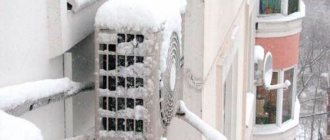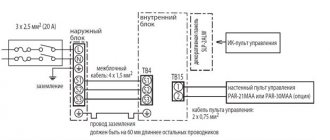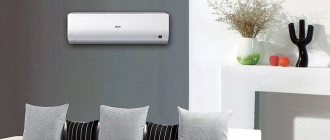In this article, we will explain in detail why the air conditioner does not blow cold air or blows with a significant delay, and how you can solve these problems.
Note! Many users are convinced that after purchasing and installing the device, they will press the button and immediately receive the long-awaited coolness. Unfortunately, it is not. The air conditioner starts blowing cold air only 10-15 minutes after turning on the mode, and budget devices can gain speed within 20 minutes. This is absolutely normal. It is worth sounding the alarm if half an hour has passed and the device has only just started working or has not started working at all.
Settings are wrong
The air conditioner may supply cold air with a significant delay or may not turn on the cooling mode at all because the settings in the control panel have gone wrong. Before use, the remote control is also configured so that it works correctly. Over time, the settings may become lost, causing the air conditioner to not receive a signal from the remote control. Or it will receive the wrong signal.
To fix this situation, you need to reset the remote control. To do this, turn off the air conditioner, including removing the plug from the outlet. After this, remove the batteries from the remote control and wait a few minutes. Insert the batteries and turn on the air conditioner. Next, try setting the cooling mode and adjusting the temperature. Wait 10-15 minutes, as the device does not work at full capacity right away.
After 15 minutes, raise your hand to the indoor unit and check the temperature of the air flows. It should feel noticeably cool. If nothing has changed, read the article further.
Excessive haste of the owners
Before you start to find out why the device does not heat the air, you should familiarize yourself with the information that the operation of air conditioners with a split system is mainly aimed at cooling the air masses, and heating them is an additional function.
For a number of reasons, climate control systems cannot become full-fledged substitutes for a heater or central heating system. The air masses in the split system are heated at the moment freon begins pumping in the reverse direction.
This procedure requires equalization of the pressure level, which will take a little time. In turn, the owners of the devices, waiting for the air conditioner to start working immediately and not receiving it, begin to think that the device has become unusable.
You can solve the problem as follows: if after turning on the device it does not start working, then you should wait a little, 10–15 minutes. It is strictly forbidden to press all sorts of buttons while waiting, try to pull the wires, and even more so disassemble the device body.
If after the above period of time the device has not begun to function, then only then can we assume a breakdown.
The indoor unit is not working correctly
The indoor unit is located indoors. It consists of many components that must work together. If one of the parts fails, the air conditioner will cool late. Sometimes the breakdown cannot be determined by ear, so you still have to call a specialist for diagnostics.
List of common indoor unit malfunctions:
- the connection between the indoor and outdoor units is lost;
- the compressor has overloaded or failed;
- the control board has failed or is not working correctly;
- temperature sensors have failed or are not working correctly;
- the valves are faulty;
- insufficient voltage in the electrical network;
Malfunction of one of the air conditioner components.
An air conditioner is a complex and multi-component device. We will provide a list of the most popular components due to which your air conditioner has stopped cooling.
- Fan of indoor/outdoor units.
As a rule, the engine burns out due to pollution and dust. The cooling capacity decreases, the compressor starts working constantly, overheats and turns off by the thermostat. - Four way valve.
Responsible for switching between “cooling/heating” modes. Stuck on “heat” mode. To be replaced. - Compressor.
The main failures are jamming, breakdown of the windings, inter-turn short circuit of the motor or breakage. Not being repaired. It changes completely. Sometimes it is more expedient (for economic reasons) to replace the entire outdoor unit - Temperature sensors.
If there is a failure, it can “read” underestimated readings, which is why the cooling is turned off ahead of time. Completely replaced with a new one. - Pressure Sensors.
They close/open or their resistance does not correspond to the normal value, while the control board does not turn on the air conditioner or does not send a signal to start the compressor, the sensors must be replaced with serviceable ones. - Capillary tube.
Due to a clogged capillary tube, a pressure difference is created at the inlet and outlet of the tube, so part of the freon boils and gives off cold even before the air conditioner evaporator. As a result, the cooling capacity of the split system decreases, and the equipment tries to compensate for its deficiency by constantly operating the compressor. If the pipeline is completely clogged, the refrigerant does not circulate, the compressor runs idle, and the air remains warm. You can try cleaning it under pressure or soldering a new one. - Control board.
As a rule, elements on the board burn out due to voltage surges. Elements can be desoldered and replaced. In case of significant damage - complete replacement.
Please pay attention! We do not recommend repairing components and assemblies of climate control equipment yourself. Leave it to the professionals. To repair an air conditioner, it is important to make the correct diagnosis and identify the exact cause of the breakdown.
The outdoor unit is not working correctly
The outdoor unit plays the same important role as the indoor unit. Together they form a single system, each component of which must work stably. If any problems occur in the outdoor unit, the air conditioner will start cooling with a significant delay, or will not cool the air at all.
Call a specialist to conduct a full diagnosis and determine the exact cause. At home, you will not be able to independently determine the cause of the malfunction, and if you do not have the necessary skills, you can damage the split system.
Make sure the air conditioner is not really cold.
Before troubleshooting the air conditioner, make sure that third-party factors do not affect the operation of the equipment:
- Working hours.
The air conditioner does not create coolness instantly. It takes 10-30 minutes. The cooling time varies depending on the power of the equipment, the size of the room, and the temperature difference: outside and the one you set on the air conditioner. - Equipment power.
A deliberately weak air conditioner will take a long time to cool a “hot” room. Especially if the room is heated all day in direct sunlight, or has large glazing. - Isolation of the room.
Pay attention to heat inflows - frequent opening of doors, windows, ventilation. Try to use curtains and blinds on window openings. - Fuel-generating equipment.
Industrial equipment, machine tools, refrigerators, grills, baking ovens, etc. generate a HUGE amount of heat. If such equipment is added to the room, do not be surprised that the air conditioner no longer copes.
If the air conditioner is selected correctly, there are no heat inflows, no additional equipment was installed - it’s time to carry out diagnostics by measuring the temperature of the incoming and outgoing air from the air conditioner.
With a working air conditioner, the temperature difference at the “input-output” is 7-15 degrees. If the difference is less than these values, then your split system really does not cool well.
In addition, you can check the outlet temperature of the flow with the passport values. Typically, the equipment passport indicates the temperature of the cooling mode at the outlet, for example, 6-14°C for non-inverter systems. When turned on, inverter systems produce similar parameters, but after reaching the set temperature in the room, the output value rises to 12-17°C degrees. If the temperature does not correspond to the passport temperature, then you should look for a problem inside the air conditioner.
Lack or excess of refrigerant
Freon
Most air conditioner users sooner or later encounter an insufficient amount of freon in the system. Leakage occurs for various reasons. If you purchased an inexpensive air conditioner, leaks may occur from the first day of operation due to poor quality assembly of the system. Also, a freon deficiency occurs due to improper installation or infrequent maintenance.
In short, there can be many reasons. But, unfortunately, you will not be able to determine on your own whether there is enough freon in the route or not. This can only be done by a specialist with experience. Use the services of a service center, they will carry out diagnostics and find out whether your air conditioner needs to be recharged.
There is also an excess of freon. This is the fault of the technicians who filled the air conditioner “by eye”. An experienced technician must correctly determine how much refrigerant is in the line and add exactly as much as needed.
If a specialist fills in freon based only on his own feelings, he most likely filled in too much. In this situation, the technician must return and correct his mistake by pumping out the unnecessary amount of refrigerant. But such situations occur infrequently; mainly there is a shortage of freon.
And the casket just opened
In 80% of cases, the cause of poor air conditioner performance is dust and dirt. Most often, the mesh filter gets clogged, which is easy to clean yourself. Simply remove it, wash it thoroughly and replace it.
This is how the air conditioner filter is removed.
If the filter is heavily soiled, you will immediately feel the airflow speed increase. Usually this is enough to restore the air conditioner's performance. But if nothing significant has happened, it’s worth cleaning it thoroughly. We wrote about this in the article “How to clean the air conditioner at home yourself - step-by-step instructions.”
Results
If your air conditioner becomes less efficient or stops cooling altogether, there is no need to worry. Try resetting the remote control and cleaning the indoor unit. Pay special attention to cleaning. If these measures do not solve the problem, contact your service center.
Believe me, such cases are far from uncommon for an experienced master. At home, you are unlikely to be able to diagnose and carry out repairs yourself. This kind of work should be entrusted to a professional. He not only has the necessary set of tools and knowledge, but also invaluable experience.
Have you ever encountered similar problems? Share your experience in the comments below. Your experience will be useful to many readers. Give some useful recommendations for those who are faced with this problem. Good luck!
Fan problems
It happens. that the air conditioner cools, but practically does not blow. We give 99% – a problem with the indoor unit fan. Most likely it stands or rotates very slowly. There are three options:
- The fan motor is broken or burned out;
- The bearing is worn out;
- Dirt at the junction of the fan and the motor prevents it from rotating.
What can be done?
- First of all, wash the fan and the place where it connects to the motor, remove all dirt;
- If after this it does not rotate normally, turn it with your fingers and listen;
- If there are extraneous sounds at the junction with the motor. You feel with your hand how something is stopping it - there is a problem with the bearing;
- If there are no extraneous sounds and the fan can be easily turned by hand, there is a problem with the motor.
You can replace the bearing or motor yourself. To do this you will need a Phillips screwdriver, half an hour of time and desire. But it’s still better to call a specialist - in case this is not the only problem.











